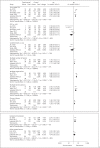Clinical and Imaging Predictors of Recurrent Ischemic Stroke: A Systematic Review and Meta-Analysis
- PMID: 29936515
- PMCID: PMC6492524
- DOI: 10.1159/000490422
Clinical and Imaging Predictors of Recurrent Ischemic Stroke: A Systematic Review and Meta-Analysis
Abstract
Background: Predictors of recurrent ischemic stroke are less well known in patients with a recent ischemic stroke than in patients with transient ischemic attack (TIA). We identified clinical and radiological factors for predicting recurrent ischemic stroke in patients with recent ischemic stroke.
Methods: A systematic search in PubMed, Embase, Cochrane Library, and CINAHL was performed with the terms "ischemic stroke," "predictors/determinants," and "recurrence." Quality assessment of the articles was performed and the level of evidence was graded for the articles included for the meta-analysis. Pooled risk ratios (RR) and heterogeneity (I2) were calculated using inverse variance random effects models.
Results: Ten articles with high-quality results were identified for meta-analysis. Past medical history of stroke or TIA was a predictor of recurrent ischemic stroke (pooled RR 2.5, 95% CI 2.1-3.1). Small vessel strokes were associated with a lower risk of recurrence than large vessel strokes (pooled RR 0.3, 95% CI 0.1-0.7). Patients with stroke of an undetermined cause had a lower risk of recurrence than patients with large artery atherosclerosis (pooled RR 0.5, 95% CI 0.2-1.1). We found no studies using CT or ultrasound for the prediction of recurrent ischemic stroke. The following MRI findings were predictors of recurrent ischemic stroke: multiple lesions (pooled RR 1.7, 95% CI 1.5-2.0), multiple stage lesions (pooled RR 4.1, 95% CI 3.1-5.5), multiple territory lesions (pooled RR 2.9, 95% CI 2.0-4.2), chronic infarcts (pooled RR 1.5, 95% CI 1.2-1.9), and isolated cortical lesions (pooled RR 2.2, 95% CI 1.5-3.2).
Conclusions: In patients with a recent ischemic stroke, a history of stroke or TIA and the subtype large artery atherosclerosis are associated with an increased risk of recurrent ischemic stroke. Predictors evaluated with MRI include multiple ischemic changes and isolated cortical lesions. Predictors of recurrent ischemic stroke concerning CT or ultrasound have not been published.
Keywords: Imaging in stroke; Ischemic stroke; Meta-analysis; Predictors of outcome; Recurrent stroke.
© 2018 S. Karger AG, Basel.
Figures
References
-
- Dhamoon MS, Sciacca RR, Rundek T, Sacco RL, Elkind MS. Recurrent stroke and cardiac risks after first ischemic stroke: the Northern Manhattan Study. Neurology. 2006;66:641–646. - PubMed
-
- de la Cámara AG, Arche JFV, Vivas PF, Guzmán JD, del Pozo SVF, Cuadrado AR, Pareja FB. Recurrence after a first-ever ischemic stroke development of a clinical prediction rule. Res Neurol Int J. 2013;2013:13.
-
- Buenaflor FGB, Navarro JC, Lara KJA, Venketasubramanian N. Recurrence rate of ischemic stroke: a single center experience. Austin J Cerebrovasc Dis Stroke. 2017;4:1057.
-
- Bergstrom L, Irewall AL, Soderstrom L, Ogren J, Laurell K, Mooe T. One-year incidence, time trends, and predictors of recurrent ischemic stroke in Sweden From 1998 to 2010: an observational study. Stroke. 2017;48:2046–2051. - PubMed
-
- Nam KW, Kwon HM, Lim JS, Han MK, Lee YS. Clinical relevance of abnormal neuroimaging findings and long-term risk of stroke recurrence. Eur J Neurol. 2017;24:1348–1354. - PubMed
Publication types
MeSH terms
LinkOut - more resources
Full Text Sources
Other Literature Sources
Medical
Miscellaneous



